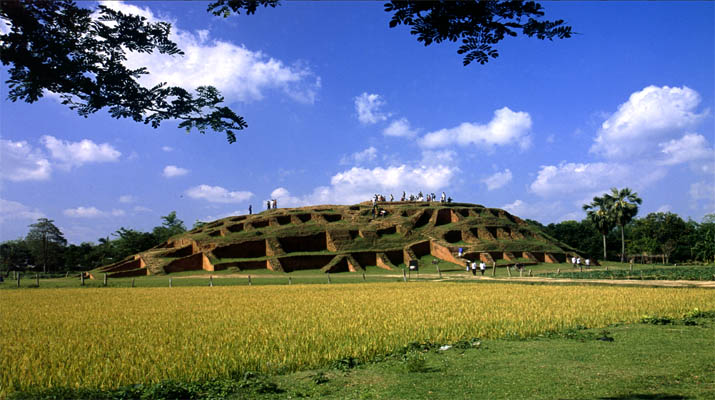Introduction
Mahasthangarh is one of the most significant archaeological and historical sites in Bangladesh. Located about 13 km north of Bogura town, it is widely recognized as the ancient capital of Pundravardhana, a powerful kingdom that existed more than 2,500 years ago. The site is not only a testimony to Bengal’s rich cultural heritage but also a fascinating destination for history lovers, archaeologists, and tourists.
In this article, we explore the history, architecture, cultural significance, and tourism value of Mahasthangarh, showcasing why it remains one of the most iconic landmarks in Bangladesh.
The History of Mahasthangarh
The name Mahasthangarh comes from the Sanskrit words Maha (great), Sthana (place), and Garh (fort), meaning “a great fortified place.” Historical records suggest that Mahasthangarh dates back to the 3rd century BCE, making it the oldest urban archaeological site in Bangladesh.
It was the capital of the Pundravardhana Kingdom, ruled by the Mauryas, Guptas, Palas, and Senas over different centuries. The site also flourished during the early medieval period as a thriving center of politics, trade, and religion.
Excavations have uncovered inscriptions, coins, terracotta plaques, pottery, and structures that confirm Mahasthangarh’s importance as a cultural and administrative hub.
Architectural Features
The site is best known for its fortified city, surrounded by massive walls that are about 5 km in circumference. The rectangular fort area measures approximately 1,500 meters by 1,400 meters and is elevated about 36 feet above the surrounding plain.
Key architectural and structural highlights include:
-
The Citadel – The main fortified area believed to have housed palaces, temples, and administrative buildings.
-
Govinda Bhita Temple – A temple dedicated to Lord Vishnu, dating back to the Gupta period.
-
Mankalir Kunda – A sacred pond associated with ancient Hindu rituals.
-
Parasuramer Basgriha – Remains of old brick structures linked to religious activities.
-
Shiladevir Ghat – A riverside bathing place with historical and cultural importance.
The impressive walls, gateways, and ancient urban planning make Mahasthangarh a remarkable site that reflects the engineering skills of ancient Bengal.
Religious and Cultural Significance
Mahasthangarh has been a melting pot of different religions, including Hinduism, Buddhism, and later Islam. Evidence of temples, stupas, and monasteries suggests the area was once a vibrant spiritual center.
-
Hindu Influence: Terracotta plaques and temples indicate devotion to Hindu gods such as Vishnu and Shiva.
-
Buddhist Heritage: Archaeologists discovered stupas and relics linked to Buddhism, showing that monks and scholars once thrived here.
-
Islamic Contributions: During the Sultanate and Mughal periods, mosques and Islamic inscriptions appeared, demonstrating cultural integration.
This blend of cultures and religions makes Mahasthangarh a symbol of Bangladesh’s diverse heritage.
Discoveries and Excavations
Excavations at Mahasthangarh began during the colonial period under British archaeologists and continued after the independence of Bangladesh. Some of the most important findings include:
-
Stone inscriptions dating back to the 3rd century BCE, written in Brahmi script.
-
Silver and copper coins from different dynasties, confirming Mahasthangarh’s role in trade.
-
Terracotta plaques with intricate carvings of deities, animals, and daily life.
-
Remains of palaces, temples, and defensive structures showing advanced urban planning.
Many of these artifacts are preserved in the Mahasthangarh Museum, located near the site, which offers visitors a deeper understanding of the region’s past.
Tourism and Travel Guide
Today, Mahasthangarh is a popular tourist attraction in Bangladesh for both domestic and international visitors. Its historical richness, combined with scenic beauty, makes it an ideal destination for history buffs, researchers, and casual travelers.
How to Reach Mahasthangarh
-
By Road: From Dhaka, visitors can take a bus or car to Bogura (approximately 200 km) and then travel a short distance to Mahasthangarh.
-
By Train: Trains from Dhaka to Bogura or Santahar provide easy access.
-
By Air: Domestic flights to Saidpur or Rajshahi airports, followed by a road journey, are also an option.
Best Time to Visit
The ideal time to visit Mahasthangarh is between October and March, when the weather is cooler and pleasant for exploring the ruins.
Nearby Attractions
-
Behula’s Basor Ghar: A legendary site associated with local folklore.
-
Govinda Bhita Temple: A well-preserved archaeological site within Mahasthangarh.
-
Bogura Town: Famous for sweets like doi (yogurt) and kachagolla.
Mahasthangarh and UNESCO Recognition
Given its immense historical and cultural value, Mahasthangarh has been proposed for recognition as a UNESCO World Heritage Site. If granted, it will join the ranks of other iconic sites in Bangladesh, such as Bagerhat and Paharpur.
Such recognition would bring global attention, encourage preservation, and boost tourism in the region, ensuring that this ancient heritage is protected for future generations.
Preservation Challenges
Despite its importance, Mahasthangarh faces several challenges:
-
Environmental Damage: Rain, floods, and natural erosion affect the site’s ruins.
-
Urban Encroachment: Expansion of nearby villages and settlements poses a threat.
-
Lack of Awareness: Many visitors fail to recognize the importance of preservation.
To address these issues, the government, UNESCO, and local organizations are working together to ensure long-term conservation.
Conclusion
Mahasthangarh stands as a monumental reminder of Bangladesh’s glorious past. As the ancient capital of Pundravardhana, it showcases a blend of history, architecture, religion, and culture spanning thousands of years.
For travelers, it is more than an archaeological site—it is a journey back in time to witness the roots of Bengal’s civilization. For historians and archaeologists, it remains a treasure trove of discoveries that continue to shed light on South Asia’s heritage.
Whether you are a local visitor or an international tourist, a trip to Mahasthangarh is a step into the heart of Bangladesh’s history. Its ruins whisper stories of kings, scholars, traders, and devotees, making it one of the most enchanting landmarks of the country.


You must be logged in to post a comment.